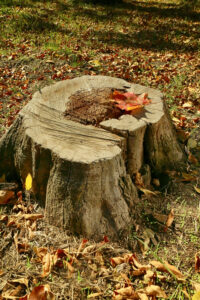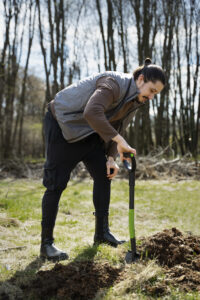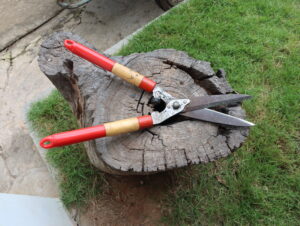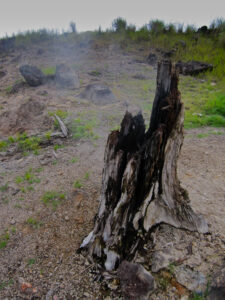How to Get Rid of Tree Stumps: DIY & Professional Tips That Work
Typically, what annoys people most about tree removal is the tree stumps left behind. Besides being an eyesore, they’re a tripping hazard, a potential home for pests, and often lead to new, unwanted growth. For these reasons, it’s worth taking care of them before they turn into a bigger problem.
The right approach to get rid of tree stumps depends on your tools, your timeline—and how much effort you’re willing to put in. For homeowners in Cheshire County and nearby New Hampshire towns, the easier option would be working with a local expert like Chris Lane Enterprises.
How to Get Rid of Small Tree Stumps (A DIY Guide)
In case you want to give it a go, removing a tree stump by hand is one of the most affordable ways to clear your yard—especially if you’re working with smaller stumps (typically 6 inches wide or less). While it doesn’t require heavy machinery or chemicals, it does demand time, effort, and the right tools.
Let’s walk through everything you’ll need and how to do it safely and efficiently.
Tools You’ll Need
| Tool | Purpose |
| Shovel | To dig around the base and expose roots |
| Loppers or Pruning Shears | To cut smaller, shallow roots |
| Hand Saw or Bow Saw | To cut thicker, deeper roots |
| Digging Bar or Mattock | To loosen soil and pry roots free |
| Work Gloves | Protect hands from blisters and splinters |
| Sturdy Boots | Ensure safe footing while digging |
| Eye Protection | Shield eyes from flying debris |
✅ Make sure to wear safety gear throughout the process. Dirt, roots, and wood splinters can cause serious injuries if you’re not properly protected.
Step-by-Step Instructions
Step 1: Expose the Roots
Use your shovel to dig around the stump, removing soil until the major roots are visible and accessible.
Step 2: Cut the Roots
Trim smaller roots using loppers or pruning shears. Use a hand saw to tackle the thicker ones. It’s helpful to cut them as close to the stump as possible to make extraction easier.
Step 3: Loosen and Wiggle the Stump
Rock the stump back and forth using a digging bar or by hand. This helps break any remaining root connections and loosens it from the ground.
Step 4: Pull The Stump Out
Once the stump feels loose enough, grab and pull it from the ground. You may need to dig under it slightly or cut any stubborn roots that weren’t fully detached.

Step 5: Fill and Level the Hole
Refill the hole with topsoil and pack it down. You can plant grass seed over the area or cover it with mulch or sod for a clean finish.

✅ Pro Tip: For small stumps, this method is cheap and effective—but it takes muscle. If the stump is over 6–8 inches wide, manual removal may become frustrating or even unsafe.
In those cases, professional stump grinding is a smarter (and faster) alternative. Reach out to our team to schedule a quote or ask about stump removal options for your property.
Other DIY Tree Stump Removal Methods That Work
If you’re looking for alternative ways to tackle stubborn tree remnants—without heavy machinery—there are a few other DIY stump removal methods worth considering. Just be aware that most of these are slower, require caution, and may not be practical for every homeowner or location.
Chemical Stump Removers
How It Works:
Chemical stump removal products accelerate the natural rotting process by softening the wood fibers inside the stump. They are typically made with potassium nitrate, and are applied after drilling holes into the stump and then left to work over the course of several weeks.
Timeline:
Expect visible softening in 4–6 weeks, with full breakdown taking 2–3 months depending on the stump’s size and wood type.
Safety and Environmental Considerations:
- Always follow the manufacturer’s instructions closely.
- Keep children and pets away from treated stumps.
- These products can leach into soil and affect nearby plantings.
- Not suitable for eco-sensitive areas or vegetable gardens.
Best For:
Homeowners who don’t need immediate results and are comfortable handling chemical products safely.
✅ Pro Tip: Use a tarp to cover the treated stump and keep moisture in as it helps speed up the decomposition process.
Burning the Stump
Legal Considerations in NH:
Before attempting this method, always check with your local fire department. Open burning may require a permit or be restricted during dry seasons.
How to Do It (Safely):
- Drill deep holes in the stump and fill with fuel (e.g., kerosene—never gasoline).
- Let the stump absorb the fuel for 24–48 hours.
- Light the stump in a controlled setting, monitoring it continuously.
- Once burned, shovel out the ashes and fill the hole with fresh soil.
Important Safety Notes:
- Never attempt this near your home, fencing, tree lines, or in windy conditions.
- Have a water source (like a hose) ready at all times.
- Fully extinguish any remaining embers before walking away.
Why It’s Risky:
Open flames near structures or wooded areas present obvious fire hazards. Smoke and toxic fumes can also be a concern, especially in residential neighborhoods.
Best For:
Rural properties with plenty of space, ideally handled by an experienced professional with the proper fire permits in place.
Epsom Salt or Rock Salt Method

How It Works:
This natural method involves drilling holes into the stump and filling them with Epsom salt (magnesium sulfate) or rock salt, then sealing the area to dehydrate and kill the stump slowly.
Timeline:
Typically takes 3–6 months to see results. Works gradually by drawing out moisture and preventing regrowth.
Why People Like It:
- Non-toxic, pet-safe, and environmentally friendly
- Affordable and easy to find at garden centers
- Minimal labor required once applied
Best For:
Homeowners who aren’t in a rush and prefer an organic approach to stump removal.
✅ Pro Tip: Covering the stump with a tarp speeds up the process by keeping moisture out and blocking sunlight.
These DIY tree stump removal methods can work—but each comes with its own set of limitations. Time, effort, and safety all play a role, so it’s important to choose the approach that truly fits your situation.
If you’d rather skip the hassle altogether, contact our team to learn more about quick and affordable professional stump removal in your area.
What to Do After Removing a Tree Stump
Once the stump is gone there are a few simple steps you can take to restore your yard and make the most of that newly cleared space.
Refill and Reseed the Area
Start by filling the hole with topsoil, packing it down to prevent future sinkholes. Add compost if you’re planning to plant and then reseed or lay fresh sod to match the rest of your lawn.
✅Pro Tip: Water regularly during the first few weeks to help new grass take root faster.
Replanting vs. Repurposing the Space
You don’t have to replant a tree—this is your chance to reimagine the space. Try:
- A flower or vegetable garden
- A gravel patio or fire pit
- Decorative mulch with potted plants
Removing a stump isn’t just the end of a project—it’s the start of a fresh idea for your outdoor space.
Should You Remove That Tree Stump? (And When It’s Essential)
Some stumps don’t need to go right away. You can tell if you need to remove a stump by checking the following: if it is rotting, attracting pests, getting in the way of mowing, or hurting your curb appeal, it’s time to take action.
In some cases, small or stable stumps can be left alone to decay naturally or even used as rustic garden features. But you should still monitor them for sprouting, soft spots, or signs of infestation—all indicators that removal is the smarter move.
When in doubt, removing a tree stump can save you time, hassle, and surprise problems later on.
When DIY Doesn’t Cut It: Why Hire a Professional for Stump Removal?
DIY stump removal often requires time, physical effort, and a lot of patience. For many homeowners, the trade-offs just aren’t worth it. That’s where hiring a professional makes all the difference.
What Homeowners Have to Say
Redditors were asked what the best way to remove a tree stump was, here’s what they said:
@TRITION23 says: recip saw, shovel, pick, crow bar, I got some huge yakka stumps out this way. Not easy but doable.
@happy_Pro493 says: I got two massive stumps ground out for $200 in under an hour. Save your back and do this.
@TheRealDabroni says: If you’ve got time on your side, cut the top of the stump as close to the ground as possible. Drill as many holes in it as you can (thicker and deeper the better) and empty as much epsom salt into it as possible. Give it a quick spray with some water and cover it with a tarp for a couple of months. This should all the roots underneath and will make chopping the stump up much easier.
The bottom line? DIY stump removal often sounds easier than it really is. What seems like a weekend project can drag on for weeks or even months—especially without the right tools or help.
Benefits of Professional Tree Stump Grinding
Besides being convenient, hiring a local professional like Chris Lane Enterprises protects your property and ensures the job gets done right the first time.
- Faster and safer: What might take you days or weeks can be done in just a few hours. Plus, there’s no risk of hurting yourself with hand tools or damaging your yard.
- No risk to utilities: Professionals know how to work around underground lines and pipes safely.
- Full clean-up: Most services include stump grinding, debris removal, and even backfilling or reseeding the area.
What to Expect from a Professional Stump Removal Service
Here’s a quick breakdown of the process:
- Site Assessment: The team will inspect the stump’s size, location, and any underground obstacles to plan the best removal approach.
- Equipment: Most pros use a stump grinder, a powerful machine that shreds the stump below ground level without disturbing your yard too much.
- Time Estimates: A single stump can often be removed in under an hour. Larger or multiple stumps may take a bit longer.
- Cost Factors: Pricing depends on stump size, root depth, soil conditions, and access to the area. Many companies offer free estimates.
💡 Want to skip the headaches and reclaim your yard? Contact our team to schedule a professional stump removal with minimal mess and zero stress.
FAQs
What is the fastest way to get rid of a tree stump?
The fastest way is professional stump grinding. We remove the stump quickly and efficiently, leaving your yard clean and ready for new growth.
How long does it take for a tree stump to rot with Epsom salt?
Using Epsom salt can take several months to over a year for a stump to fully decompose. It’s a natural method, but not a quick one.
How to stop a tree stump from growing?
To stop regrowth, we need to remove the root system or apply a stump killer herbicide. We would grind the stump to prevent sprouts.
Can you get rid of a tree stump without grinding it?
Yes, you can dig it out, burn it, or speed up decomposition with chemicals or natural methods like Epsom salt. However, grinding is usually the most effective and least labor-intensive.
How much does tree stump removal cost?
The cost of removing a tree stump depends on factors like the size of the stump, its location, how accessible it is, and the method used. In general, larger or harder-to-reach stumps tend to cost more to remove. We would be glad to provide a professional assessment to understand the cost for your specific situation.
Why shouldn’t you leave a tree stump in the ground?
Stumps can attract pests, spread disease to healthy trees, become tripping hazards, and interfere with landscaping or new plantings.
What can you put on a tree stump to dissolve it?
You can use stump removal products containing potassium nitrate or natural options like Epsom salt. Both help accelerate decomposition over time.



